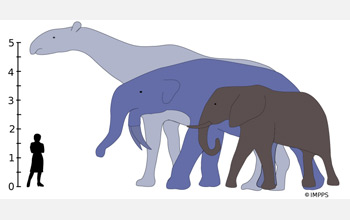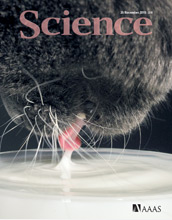All Images
News Release 10-224
Mammals Grew 1,000 Times Larger After the Demise of the Dinosaurs
NSF enabled the assembly of an international, interdisciplinary team that was the first to quantitatively document body size patterns over the past 100 million years
This material is available primarily for archival purposes. Telephone numbers or other contact information may be out of date; please see current contact information at media contacts.

The largest land mammals that ever lived, Indricotherium and Deinotherium, would have towered over the living African Elephant. Indricotherium lived during the Eocene to the Oligocene Epoch (37 to 23 million years ago) and reached a mass of 15,000 kg, while Deinotherium was around from the late-Miocene until the early Pleistocene (8.5 to 2.7 million years ago) and weighed as much as 17,000 kg.
Credit: NSF RCN IMPPS
Download the high-resolution JPG version of the image. (90 KB)
Use your mouse to right-click (Mac users may need to Ctrl-click) the link above and choose the option that will save the file or target to your computer.
Principal investigator Felisa Smith from the University of New Mexico describes the discovery. She discusses her research in its goals; she describes how the demise of dinosaurs paved the way for mammals to get bigger; and she outlines the results of the data.
Credit: Videotaped by Steve Carr, University of New Mexico
Edited by Lisa-Joy Zgorski, Steve McNally, and John Wassel, NSF
Principal investigator Felisa Smith from the University of New Mexico describes the composition of her research team and the manner in which the team collected, organized and synthesized data to quantitatively explore the patterns of body size of mammals after the demise of the dinosaurs.
Credit: Videotaped by Steve Carr, University of New Mexico
Edited by Lisa-Joy Zgorski, Steve McNally, and John Wassel, NSF

This research is detailed in "The Evolution of Maximum Body Size of Terrestrial Mammals," in the November 26, 2010 issue of the journal Science. The following researchers authored the paper: Felisa Smith (UNM), Alison Boyer (Yale), James Brown (UNM), Daniel Costa (UC Santa Cruz), Tamar Dayan (Tel-Aviv University, Israel), S.K. Morgan Ernest (Utah State University), Alistair Evans (Monash University, Australia), Mikael Fortelius (University of Helsinki, Sweden), John Gittleman (University of Georgia), Marcus Hamilton (UNM), Larisa Harding (Umea, Sweden), Kari Lintulaakso (University of Helsinki), S. Kathleen Lyons (Smithsonian Institution), Christy McCain (University of Colorado), Jordan Okie (UNM), Juha Saarinen (University of Helsinki), Richard Sibly (University of Reading, UK), Patrick Stephens (University of Georgia), Jessica Theodor (University of Calgary, BC), and Mark Uehn (George Mason University).
Credit: copyright AAAS 2010
Download the high-resolution JPG version of the image. (1 MB)
Use your mouse to right-click (Mac users may need to Ctrl-click) the link above and choose the option that will save the file or target to your computer.


